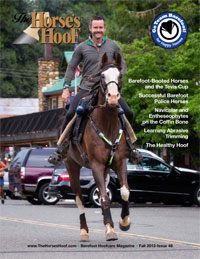 “The harem group has a clear hierarchy in which the stallion and head mare are the two most central individuals in a very literal sense. The head mare is often referred to as the lead mare, but this can easily lead to some confusion about her actual role. An easy way of thinking about the head mare is as the ‘general’ of the group. Her place is at the centre of the group, where she is protected by a screen of lower status mares. She is the single most important member, and the group’s primary decision maker. Head mares are ‘elected’ to their position by group consensus. The position cannot be captured by aggressive behavior, nor can it be maintained by tyranny. So while the head mare is certainly the highest status female in the group, and is in many ways far more important to their survival than is the stallion, there is no need for her to physically dominate other mares and it would be a betrayal of her freely accorded status were she to do so. Lower status mares may improve their standing by achieving an alliance with the head mare – a win-win element of equine female social politics.” …
“The harem group has a clear hierarchy in which the stallion and head mare are the two most central individuals in a very literal sense. The head mare is often referred to as the lead mare, but this can easily lead to some confusion about her actual role. An easy way of thinking about the head mare is as the ‘general’ of the group. Her place is at the centre of the group, where she is protected by a screen of lower status mares. She is the single most important member, and the group’s primary decision maker. Head mares are ‘elected’ to their position by group consensus. The position cannot be captured by aggressive behavior, nor can it be maintained by tyranny. So while the head mare is certainly the highest status female in the group, and is in many ways far more important to their survival than is the stallion, there is no need for her to physically dominate other mares and it would be a betrayal of her freely accorded status were she to do so. Lower status mares may improve their standing by achieving an alliance with the head mare – a win-win element of equine female social politics.” …
“With this in mind we come to the dominance behaviors used by human trainers. Use of round pens to set up the ‘drive’ has no real analogue with natural behavior. There is no level on which it makes any sense to the horse to be subjected to ejection behavior but confined to prevent escape. What must surely result is confusion and panic – and after a time, depending on the strength of the particular horse’s will, the outcome will be learned helplessness or injury, potentially fatal, or an attack on the trainer. …
One of the things that is often said of ‘dominance strategies’ is that by doing this the horse is made to acknowledge the human as a higher status horse. Is it not amazing that horses should be thought of as so stupid that they could possibly imagine a human was another horse? But if we did want the horse to accept us, learn from us and trust us we would want to behave as if we were a head mare, or perhaps benevolent and protective harem stallion – in which case we would signal our high status best by regular and predictable socialising, unflappable calmness, confidence and self-control.”
— Andy Beck, “Dominance and the Horse”
http://www.whydoesmyhorse.co.uk/oldsite/pdf/Dominance%20-%20UK%20Behaviourist%20site.pdf
The excerpts posted here are an introduction to the path upon which I am being led and have been led for many years but now quickening my steps to share with others. Too often, way too often, I see handlers and ‘trainers’ who feel the need to dominate the horse. When one is seeking to TEACH the horse a new task or to TEACH the horse that a particular behavior is not accepted, the word ‘dominance’ becomes moot. ‘Dominance’ and ‘teaching’ are not words that should be coupled.
Dominance lends itself to an air of superiority and control. That which seeks to control a situation.
Teaching is a word that denotes care, respect for the student, sharing, working and studying WITH the student – not beating lessons into the student and punishing for the ‘wrong answers’.
It is my thought that those who feel the need to whip a horse or punch or kick a horse do so out of this skewed view of ‘dominating’ the horse and ‘showing him who’s boss’ or meting out behavior that ‘is just what a boss mare would do”. This type of response to an unwanted behavior from a horse sets the human handler’s own response of fear. That fear response automatically takes the handler into a defensive position thereby exuding an intent of harm. Of self defense.
If a horse is displaying a behavior which is contrary to what is being requested then it is clear that the horse either:
a. does not understand what is being asked.
b. cannot do what is being asked or
c. the request is causing fear in the horse in which case the horse MUST move its hooves and initiate the flight response by default. The response may trigger a memory of past abuse or may be such that the energy and intent that accompanies the request is one of ‘dominance’ and aggression – that aggression being born from the initial fear response of the handler.
Studies have shown that behaviors that are forced through punishment are ones that will extinguish themselves when the punishment is not forthcoming. —
Effects of Punishment :: It has been clearly and repeatedly demonstrated that punishment can very effectively be used to control behavior. So, why do behaviorists usually warn against using it? Simply because we can almost always control behavior just as effectively by using reinforcement as by using punishment, and without having to put up with the problems and negative side effects of punishment. If we wish to stop a behavior that is already occurring, we can usually do so by simply eliminating the reinforcement for the behavior — a process we call extinction.
The following is only a partial list of the problems and negative side effects resulting from the use of punishment to control behavior. Others could easily be added.
The following most directly apply to corporal punishment, but should also be considered when contemplating other forms of punishment.
1. PUNISHMENT OFTEN FAILS TO STOP, AND CAN EVEN INCREASE THE OCCURRENCE OF, THE UNDESIRED RESPONSE.
Since attention is one of the most potent rewards available, and since it is difficult to punish without paying attention to the offender, punishing may serve more as a reward than as a punishment.
2. PUNISHMENT AROUSES STRONG EMOTIONAL RESPONSES THAT MAY GENERALIZE.
Once the strong emotional responses are aroused the degree and direction of generalization is largely uncontrollable. The result may be excessive anxiety, apprehension, guilt, and self-punishment.
3. USING PUNISHMENT MODELS AGGRESSION.
The meaning of “social power is exemplified.
4. INTERNAL CONTROL OF BEHAVIOR IS NOT LEARNED.
The offender may learn to inhibit the punished response during surveillance, but once surveillance ends there is no internal control mechanism to continue inhibiting the behavior.
5. PUNISHMENT CAN EASILY BECOME ABUSE.
Most parents who abuse children do not intend to do the damage they inflict. Most of the damage and injury occurs when the parent loses control, and goes beyond the boundaries of reasonable behavior.
6. PAIN IS STRONGLY ASSOCIATED WITH AGGRESSION.
The pain of punishment often leads to a display of aggression against either the source of the pain or, in some cases, an innocent scapegoat.
7. PUNISHMENT WORKS BEST WHEN IT OCCURS EVERY TIME.
While reward works best when given on an intermittent basis, punishment works best when a continuous basis. The degree of vigilance required to constantly monitor behavior so that every occurrence of the undesired behavior can be punished is rarely possible. The undesired behavior is, therefore, intermittently reinforced when it is not punished, and the behavior continues. —http://www.oklahoma.net/~jnichols/PunishmentProblems.html
The studies also have shown the contrary – those behaviors that are rewarded with positive reinforcement are those that will remain and become conditioned responses to the particular cue/request. This is due to the dopamine levels that rise exorbitantly when a request is made, the behavior is ‘marked’ and the outcome is known to bring a reward. : “spikes in dopamine levels occur with anticipation of pleasure rather than at the point of pleasure.” (Robert Sapolsky) —http://www.dailymotion.com/video/xhnej9_robert-sapolsky-on-the-dopamine-and-pleasure_tech
Given this information what do you choose to do today with your horse? Punish for the ‘wrong’ behavior or mark and reward the ‘right answers’?










